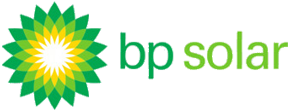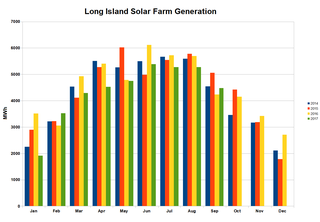This is a list of solar energy topics.

BP Solar was a manufacturer and installer of photovoltaic solar cells headquartered in Madrid, Spain, with production facilities in Frederick, MD, India and the People's Republic of China. It was a subsidiary of BP.

Spain is one of the first countries to deploy large-scale solar photovoltaics, and is the world leader in concentrated solar power (CSP) production.

The Waldpolenz Solar Park is a 52-megawatt (MW) photovoltaic power station built by German developer and operator Juwi at a former military air base near Leipzig, Eastern Germany. When completed by the end of 2008, it was the world's largest thin-film solar park using CdTe-modules.
The Pocking Solar Park is a photovoltaic power station in Pocking, Lower Bavaria, Germany. It has installed capacity of 10 megawatts. Construction and assembly of the power plant begun in August 2005 and was completed in March 2006.

The Erlasee Solar Park, or Solarstrompark Gut Erlasee, is an 11.4 megawatt (MW) photovoltaic power station located in Bavaria, southern Germany, in one of the sunniest regions of the country. Constructed on a former vineyard by the company Solon SE in 2006, it was then the world's largest photovoltaic power station.

Gottelborn Solar Park is an 8.4-MWp photovoltaic power station located in Göttelborn, in Quierschied municipality, Germany. The power plant was constructed by City Solar in two stages. The first stage was completed in August, 2004, followed by the second stage three years later in November 2007.
Between 1992 and 2022, the worldwide usage of photovoltaics (PV) increased exponentially. During this period, it evolved from a niche market of small-scale applications to a mainstream electricity source.

The Strasskirchen Solar Park is a large photovoltaic power station in Bavaria, with an installed capacity of 54 MW. It was developed by a joint venture of MEMC and Q-Cells in 2009. At this time this Solar Park was the second largest PV Power Plant. Q-Cells also provided the solar modules for the facility which is located in Straßkirchen, Bavaria, Germany.

The Finsterwalde Solar Park was, in November 2010, the world's largest photovoltaic plant with 80.7 MWp. The project is located in Finsterwalde, Germany and is equipped with Q-Cells modules and LDK solar wafers.
The Köthen Solar Park is a photovoltaic power station in Köthen, Germany. It has a capacity of 45 megawatts (MW) and an expected annual electricity generation of 42 gigawatt-hours. The solar park was developed and built by RGE Energy.

The 32 megawatt AC Long Island Solar Farm (LISF), located in Upton, New York, was the largest photovoltaic array in the eastern U.S. in November 2011. The LISF is made up of 164,312 solar panels from BP Solar which provide enough electricity for roughly 4,500 households. The project will cause the abatement of more than 30,000 metric tons of carbon dioxide emissions per year. LISF is co-owned by BP Solar and MetLife through Long Island Solar Farm LLC. Municipal utility Long Island Power Authority (LIPA) buys the 37-megawatt (49,600 hp) power plant's output, which is estimated at 44 GWh annually, under a 20-year power purchase agreement (PPA). Payments over that time are expected to total $298 million. The project was engineered by Blue Oak Energy and construction subcontracted to Hawkeye LLC from Hauppauge, New York. The plant earned the Best Photovoltaic Project of Year Award from the New York Solar Energy Industries Association. The panels are mounted at a fixed tilt angle of 35°, with the rows spaced approximately 18 ft 4 in (5.59 m) apart.

Solarpark Eiche is a 26.5-megawatt (MW) photovoltaic power station located in Ahrensfelde‐Eiche, Germany, near the capital Berlin, and covers an area of 73 hectares.
The Fürstenwalde Solar Park is a photovoltaic power station in Fürstenwalde, Germany. It has a capacity of 39.64 megawatt (MW) and an annual output of 36.5 GWh. The solar park was developed by the company Solarhybrid and built by conecon using 62,832 225-watt and 110,880 230-watt solar panels, both manufactured by Suntech.
The Solarpark Heideblick is a photovoltaic power station in Heideblick, Germany. It has a capacity of 27.5 megawatts (MW). The solar park was developed and built by Enerparc.
Reckahn Solar Park is a photovoltaic power station in Reckahn, southwest of Berlin, Germany. It has a capacity of 37.7 megawatt (MW) and was constructed in three phases. Reckahn I was 22.661 MW covering 56 hectares and was built by Beck Energy GmbH (Belectric) using 292,000 First Solar thin-film CdTe-panels, and was expected to produce about 22 gigawatt-hours per year. Reckahn II added 13.3 MW, using 172,000 modules on a 35 hectares site. Reckahn III, completed in 2011, added 1.8 MW, bringing the total to 37.7 MW. The FIT is 21.1 Euro cents per kilowatt-hour.

Brandenburg-Briest Solarpark is photovoltaic power station, located at a former military airfield in Brandenburg, Germany. At the time of its completion, it was the largest solar park in Europe. Equipped with Q-Cells solar modules, it consists of three sections, namely
Neuhardenberg Solar Park is a 145-megawatt (MW) photovoltaic power plant, and was Europe's largest solar power station, located at the former Neuhardenberg military airport in Brandenburg, Germany.

Templin Solar Park is a 128 megawatt (MW) photovoltaic power station, located at the former Templin military airport.

The Perleberg Solar Park is a photovoltaic power station, with an installed capacity of 35 megawatts (MW). It uses 144,144 solar panels manufactured by Chinese company Yingli. The panels are mounted at a fixed angle on posts that are driven into the ground, at a former military airport.












